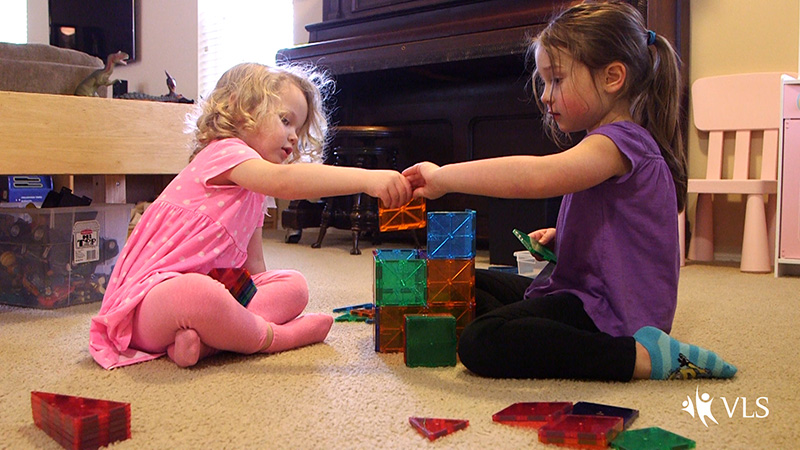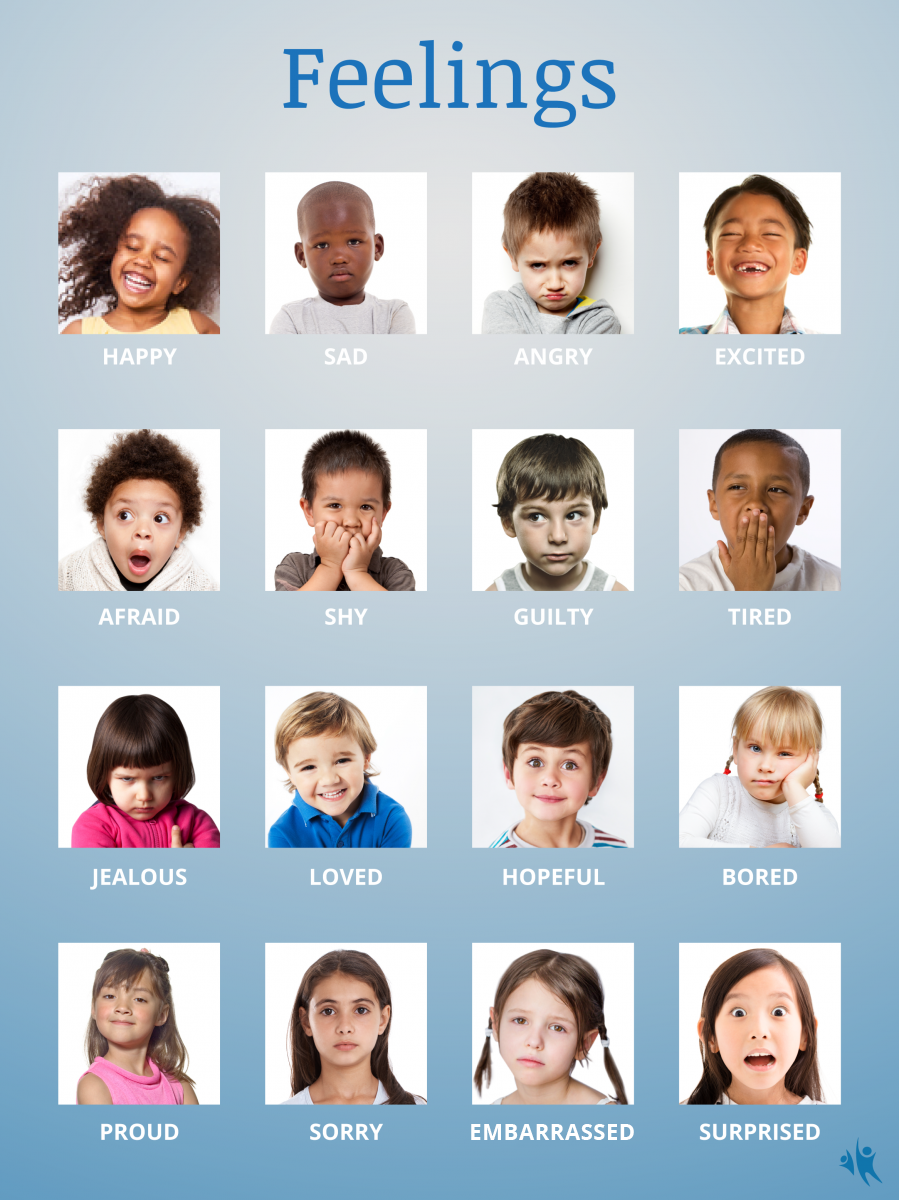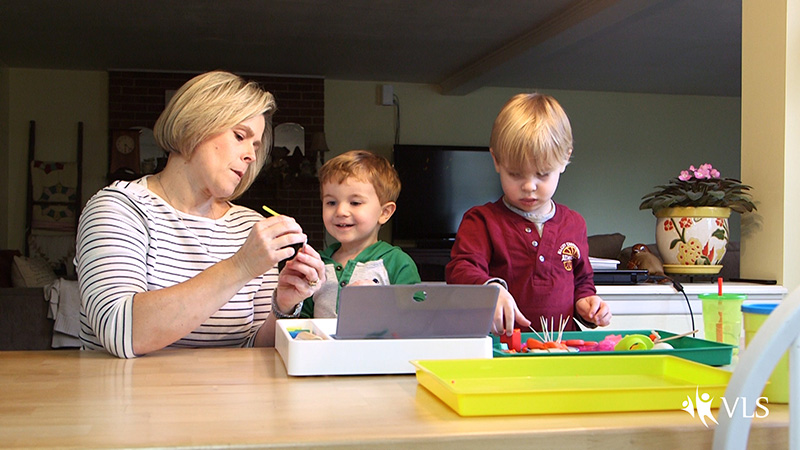- Examine how you can embed opportunities for social-emotional learning and development during daily routines and activities.
- Discuss how you can support the social-emotional skills of all the children in your care.
- Identify how to promote positive relationships among the children in your family child care home.
Learn
Know
The children you care for need daily opportunities to participate in activities that help them learn new skills, and practice existing skills, in a fun, stimulating, and supportive environment (your home). Children develop social-emotional skills in the context of their relationships with their primary caregivers—including you as their child care provider—and within their family and culture. Children’s social-emotional development affects their ability to have successful school and life outcomes. During your daily activities and routines, you can embed opportunities to enhance children’s social-emotional learning.
Embedding Opportunities for Social-Emotional Development
The first step to embedding opportunities for social-emotional development is to get to know all the children in your care. This involves observing them. Note their interests, their interactions with peers, and their ability to express emotions. As you learn about the children, you can use this information to think about activities they may enjoy and how to facilitate the development of social skills and friendships. Think about:
- What experiences can you provide to support the children’s abilities to learn to self-regulate?
- How can you incorporate social-emotional learning into your daily schedule and routines?
- How can you make snack times and lunchtime routines that support social development?
Learning socially appropriate ways to interact may be difficult for some young children as they are just learning to regulate their emotions. Young children learn how to ask for help, comfort a friend, and express their anger by watching and listening to trusted adults.
In the Explore section of this lesson, you will find examples of planning and embedding opportunities for social-emotional development in daily routines. You can intentionally arrange your experiences and routines to ensure that you provide opportunities for social-emotional learning and growth throughout your day.
Once you have assessed and planned for social-emotional learning opportunities, the next step is implementing your plan. In doing so, build on experiences in which the children in your classroom are actively engaged. With careful planning, you can embed social and emotional learning strategies into multiple experiences and routines in your family childcare setting. You will need to continuously assess children’s progress and adapt your strategies to nurture their development as the children in your care learn new skills.
Promoting Friendships
Friendship skills begin developing in young children and change over time. Toddlers are aware of other children but are not typically concerned with group play activities or making friends. They often play next to other children even when using the same toys.

Preschoolers are just beginning to understand how to be a friend and what it means to play cooperatively with other children. They can sustain group games and play scripts. They are beginning to form friendships that may carry over outside of child care (such as at someone’s home for a playdate).
School-age children typically enjoy playing with others their age. They enjoy cooperative games, competitive games, playing sports, and attending birthday parties. School-age children generally gravitate to peers who have similar interests. Friendships become more and more important as children mature.
As a family child care provider, you can use many activities to promote friendship skills among the children in your care:
- Include plenty of toys and materials that promote social interactions (e.g., dress-up clothes, blocks, balls, puppets, cars, trucks, and board games).
- Arrange play areas so more than two children can play together (or side-by-side).
- Read books about friends, cooperation, helping each other, emotions, and empathy.
- Practice sharing and turn taking during routines (snack, lunch, group-meeting time).
- Ask children to help one another during the day. Model this behavior and ask older children to assist younger children with tasks.
- Include the shared interests of children in areas of your home (e.g., if a child is interested in polished rocks, place some in a basket in a play area).
- Model talking about your own emotions and support children when they share their emotions. This may feel strange at first, but gets easier as you do it, “I feel disappointed because the weather forecast says it is supposed to rain a lot today, and I wanted to take us all to the farmers’ market.”
- Make suggestions to children about play themes or suggest a particular group project. “I can see that several of you are interested in the types of birds that come to our bird feeder. Let’s start a project and document the types of birds we see each day.”
- Include outdoor play equipment and toys that involve children working together (wagon, sand toys, etc.).
Some children may need extra encouragement from you to learn to play with another child including skills such as, taking turns, asking for a turn, or taking on a role in a play scheme. Pay close attention and be mindful about when it is good to intervene in the children’s play and when to observe.
Problem-Solving Activities
Just as in any groups, conflicts may arise at times in your family child care home. Conflicts or disagreements are considered teachable moments, which are opportunities for you to demonstrate skills such as problem-solving skills. Consider using materials and activities to incorporate these teachable moments into everyday learning rather than waiting until a problem arises. Characters in children’s books often have problems they need to solve. When reading or telling a story, ask the children to think about ways the character in the story solves a problem. Allow children to brainstorm ideas and perhaps even write them down and post them if they think of different solutions to the character’s problem. Many resources are available that describe how to teach children problem-solving steps. Another example is to use a Peace Table to indicate a physical space where children can sit down together and solve a disagreement.
Diane Trister Dodge and her colleagues (2020) recommend using the following sequence or steps for teaching children problem solving:
- Identify the problem. For example, perhaps children building with blocks are interfering with children playing a board game on the floor.
- Brainstorm possible solutions. Invite children to share ideas about how to solve the problem. Invite everyone to suggest a solution. Write the ideas on paper and go over them with the children.
- Agree on a solution. Restate the children’s ideas and ask them to think about the best way to solve the problem. Make sure everyone has the same understanding of the solution. Clarify any questions.
- Try the solution and see how well it works. Remember to give the solution enough time to work. If the original solution doesn’t solve the problem, help the children try another idea.
Fostering Emotional Literacy
Emotional literacy is the ability to identify, understand, and respond to emotions in oneself and others in appropriate ways. One way to foster emotional literacy in children is by offering activities and experiences that build children’s emotional vocabulary. The development of an emotional vocabulary helps children to better understand their emotional experiences, discuss and reflect with others, and communicate with others about their feelings. You can foster emotional literacy among children using the following strategies:
- Express your own feelings. Talk out loud about your feelings as you experience them throughout the day. You can help children learn to label their emotions by modeling healthy emotional expressions.
- Label children’s feelings. Provide feeling names for children’s emotional expressions. Attend to children’s emotional moments and label feelings for children by saying things like “You look really disappointed about the block structure” or “I can see your really frustrated that they took your toy”.
- Play games, sing songs, and read stories with new feeling words. Sing songs like “If you’re happy and you know it” and change up the verses to include new feeling words like angry, excited, frustrated etc. Allow children to act out different feeling faces from magazines or act out different emotions at circle time. Place a feelings chart in your environment and have children “check in” in the mornings by selecting a face that best represents how they are feeling.

Addressing the Social-Emotional Needs of All Children
You may encounter children in your family child care setting who have special needs, developmental delays, or may be experiencing challenging life events or circumstances. These challenges may affect the child’s ability to engage in positive social interactions with adults and peers. It is important to provide children with the support they need so they can benefit as much as possible from their early care and education experiences.
 For some children, you will need to work closely with the family, share observations and documentation, and perhaps work with a consultant from an agency or school district that their family has contacted. An infant or toddler with special needs may have an Individual Family Service Plan (IFSP) that describes all the special services for the child and family. A preschool or a school-age child with a disability may have an Individual Education Program (IEP) that typically addresses school-based special services and supports. Children with disabilities often need changes or adaptations to materials, environments, and routines. They may also have specific behavior plans that you and their parents need to carefully implement and monitor. You will want to ask the child’s family to help you receive any specific training or supports if you are expected to implement any individual social or emotional behavior strategies for a child with disabilities or developmental delays.
For some children, you will need to work closely with the family, share observations and documentation, and perhaps work with a consultant from an agency or school district that their family has contacted. An infant or toddler with special needs may have an Individual Family Service Plan (IFSP) that describes all the special services for the child and family. A preschool or a school-age child with a disability may have an Individual Education Program (IEP) that typically addresses school-based special services and supports. Children with disabilities often need changes or adaptations to materials, environments, and routines. They may also have specific behavior plans that you and their parents need to carefully implement and monitor. You will want to ask the child’s family to help you receive any specific training or supports if you are expected to implement any individual social or emotional behavior strategies for a child with disabilities or developmental delays.
Recognize that some children you care for may be dealing with challenging life circumstances. Such challenges may require specialized services. In order to help children build resilience to deal with stressful life events, you can tell families about local community or installation services. Keep informed and have web addresses, phone numbers, and contacts for social service agencies and programs in your community handy so you will be ready to assist families when they seek services for themselves and their child.
As a family child care provider, you know the children in your home well and can facilitate helping children build peer relationships and friendships. Some ways to do this include:
- Pair children to take turns with a new musical instrument.
- Create small groups of mixed-age children to read a book together.
- Teach young children to respond to a peer’s request to play.
- Extend play by adding new materials to an ongoing pretend play activity.
- Create personalized social stories or scripts to assist children who have difficulty with transitions, new routines, or recalling what happens next.
- Redirect children when they engage in challenging behavior.
Family Involvement
As a family child care provider, you have the wonderful opportunity to communicate with each child’s family on a daily basis. Families are a wonderful resource when you are planning activities that promote social-emotional development. Parents know their children best and can inform you about their child’s interests, family outings, pets, and other news that can enhance your relationship with each child. Posting family pictures of your own family and the families of the children you care for helps make your home warm and nurturing.
Take time each day to speak positively to and about the families of the children in your care. Your relationship with a family helps enhance their child’s social-emotional development. You are an important adult in their child’s life. Children need to see the important adults in their lives (parents and caregivers) talking and treating each other respectfully. Talking to children about the positive things their families do or say will also help to enhance the social-emotional skills of each child.
Families may want to arrange play dates with other families and get to know one another. It is important to ask families if they want you to share their contact information with another family. You can serve as the connection between families and help them to find common interests or friendships outside of your family child care setting.
Do
Responsive and engaging environments are created with intentional, frequent use of developmentally appropriate interactions and experiences, including opportunities for social-emotional growth. In your daily interactions with the children in your family child care setting, consider the following:
- Remember that infants and toddlers are watching your expressions and learning ways to respond to strong emotions—use “I” statements and describe your feelings during interactions.
- With younger children, think about tantrums in terms of self-regulation and help child regain focus and attention.
- Notice and describe prosocial behaviors and help children work through conflicts.
- Be responsive to children’s attempts to use social skills or express emotions. Build on what they are saying or doing.
- Provide frequent, developmentally appropriate models through daily activities and routines.
- Follow children’s cues and preferences.
- Embed activities about emotions into daily routines.
- Ask children questions about their feelings, actions, interests, or life events. Reinforce them for using emotion words, appropriately sharing emotions, or demonstrating appropriate social skills. Consider creating a reinforcement system where children can earn stickers, tokens, or points for labeling their own emotions.
- Tell families about some of the activities, experiences, or strategies you use in your classroom to help children practice social-emotional skills at home.
- Support children as they develop their social skills by creating an environment based on respect and kindness.
- Model healthy ways to express emotions, interact with others, and cope with stress.
- Allow for the development of social skills to occur naturally in the learning environment by giving children time to play and interact in an unstructured way. Give children time to relax, imagine, and have conversations with their peers.
Explore
Review and complete the Teaching Problem-Solving activity and use the examples to think about how you can embed social-emotional learning, problem-solving, friendship building, and creating a caring community into your family child care home. Share your responses with your trainer, coach or family child care administrator.
Review the additional resources in this section for ideas for promoting, embedding and supporting social-emotional learning.
It is important to offer learning experiences and activities that are appropriate, engaging and supportive of children’s learning and development across various developmental domains including cognitive, social-emotional, physical, language and literacy, and creative development. Providers working toward their CDA credential should use the CDA Social Skills Activity Plan handout to develop an emotional skills/regulation learning experience from your curriculum (or a new activity you plan on implementing).
Apply
You may be caring for children in various stages of social-emotional development. Intentionally planning for mixed ages of children can be challenging. It is important to have a clear idea of what you want the individual children to be able to do during a planned play activity. Read the handout, complete it, and share your plan with your trainer, coach, or family child care administrator. What social-emotional strategies might you embed into your activity?
Glossary
Demonstrate
Center on the Social and Emotional Foundations for Early Learning (CSEFEL). (n.d.). http://csefel.vanderbilt.edu/resources/strategies.html
Dodge, D. T., Rudick, S., & Colker, L. J. (2020). The creative curriculum for family child care (3rd ed.). Teaching Strategies.
Harms, T., Cryer, D., Clifford, R. & Yazejian, N. (2019). Family child care environment rating scale (3rd ed.). Teachers College Press.
Head Start Early Childhood Learning & Knowledge Center. (2021). Fostering emotional literacy in young children: Labeling emotions. https://headstart.gov/mental-health/article/fostering-emotional-literacy-young-children-labeling-emotions
Head Start Center for Inclusion. Social stories. http://depts.washington.edu/hscenter/social_stories
Playworks. (2020). Game library. https://www.playworks.org/game-library/
Zero to Three. Developing social-emotional skills. https://www.zerotothree.org/resources/series/developing-social-emotional-skills.


